Anas Mahmoud
Large Self-Supervised Models Bridge the Gap in Domain Adaptive Object Detection
Mar 29, 2025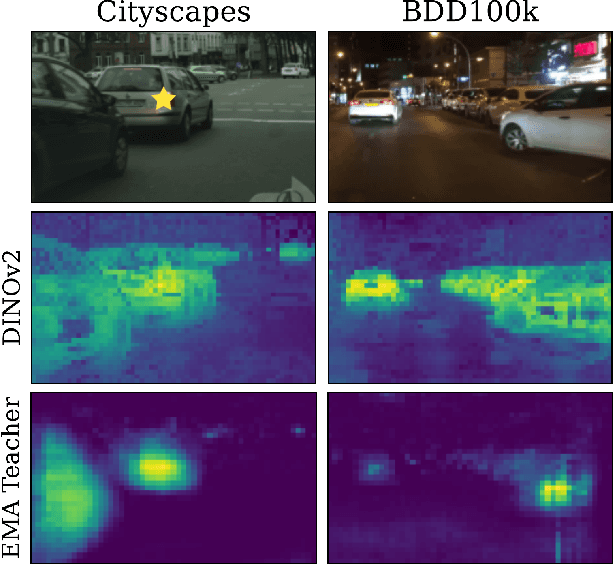

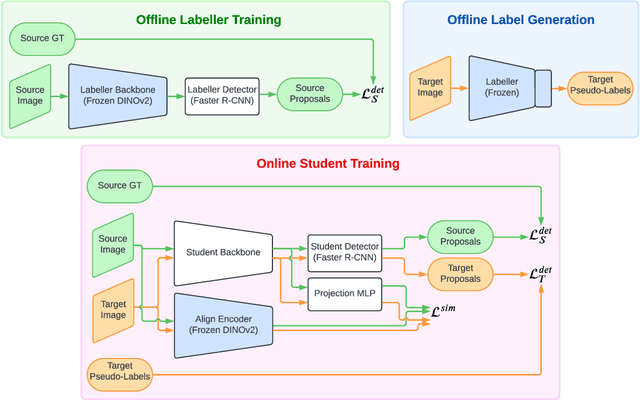

Abstract:The current state-of-the-art methods in domain adaptive object detection (DAOD) use Mean Teacher self-labelling, where a teacher model, directly derived as an exponential moving average of the student model, is used to generate labels on the target domain which are then used to improve both models in a positive loop. This couples learning and generating labels on the target domain, and other recent works also leverage the generated labels to add additional domain alignment losses. We believe this coupling is brittle and excessively constrained: there is no guarantee that a student trained only on source data can generate accurate target domain labels and initiate the positive feedback loop, and much better target domain labels can likely be generated by using a large pretrained network that has been exposed to much more data. Vision foundational models are exactly such models, and they have shown impressive task generalization capabilities even when frozen. We want to leverage these models for DAOD and introduce DINO Teacher, which consists of two components. First, we train a new labeller on source data only using a large frozen DINOv2 backbone and show it generates more accurate labels than Mean Teacher. Next, we align the student's source and target image patch features with those from a DINO encoder, driving source and target representations closer to the generalizable DINO representation. We obtain state-of-the-art performance on multiple DAOD datasets. Code available at https://github.com/TRAILab/DINO_Teacher
Image-to-Lidar Relational Distillation for Autonomous Driving Data
Sep 01, 2024



Abstract:Pre-trained on extensive and diverse multi-modal datasets, 2D foundation models excel at addressing 2D tasks with little or no downstream supervision, owing to their robust representations. The emergence of 2D-to-3D distillation frameworks has extended these capabilities to 3D models. However, distilling 3D representations for autonomous driving datasets presents challenges like self-similarity, class imbalance, and point cloud sparsity, hindering the effectiveness of contrastive distillation, especially in zero-shot learning contexts. Whereas other methodologies, such as similarity-based distillation, enhance zero-shot performance, they tend to yield less discriminative representations, diminishing few-shot performance. We investigate the gap in structure between the 2D and the 3D representations that result from state-of-the-art distillation frameworks and reveal a significant mismatch between the two. Additionally, we demonstrate that the observed structural gap is negatively correlated with the efficacy of the distilled representations on zero-shot and few-shot 3D semantic segmentation. To bridge this gap, we propose a relational distillation framework enforcing intra-modal and cross-modal constraints, resulting in distilled 3D representations that closely capture the structure of the 2D representation. This alignment significantly enhances 3D representation performance over those learned through contrastive distillation in zero-shot segmentation tasks. Furthermore, our relational loss consistently improves the quality of 3D representations in both in-distribution and out-of-distribution few-shot segmentation tasks, outperforming approaches that rely on the similarity loss.
An Introduction to Vision-Language Modeling
May 27, 2024


Abstract:Following the recent popularity of Large Language Models (LLMs), several attempts have been made to extend them to the visual domain. From having a visual assistant that could guide us through unfamiliar environments to generative models that produce images using only a high-level text description, the vision-language model (VLM) applications will significantly impact our relationship with technology. However, there are many challenges that need to be addressed to improve the reliability of those models. While language is discrete, vision evolves in a much higher dimensional space in which concepts cannot always be easily discretized. To better understand the mechanics behind mapping vision to language, we present this introduction to VLMs which we hope will help anyone who would like to enter the field. First, we introduce what VLMs are, how they work, and how to train them. Then, we present and discuss approaches to evaluate VLMs. Although this work primarily focuses on mapping images to language, we also discuss extending VLMs to videos.
LayerSkip: Enabling Early Exit Inference and Self-Speculative Decoding
Apr 29, 2024Abstract:We present LayerSkip, an end-to-end solution to speed-up inference of large language models (LLMs). First, during training we apply layer dropout, with low dropout rates for earlier layers and higher dropout rates for later layers, and an early exit loss where all transformer layers share the same exit. Second, during inference, we show that this training recipe increases the accuracy of early exit at earlier layers, without adding any auxiliary layers or modules to the model. Third, we present a novel self-speculative decoding solution where we exit at early layers and verify and correct with remaining layers of the model. Our proposed self-speculative decoding approach has less memory footprint than other speculative decoding approaches and benefits from shared compute and activations of the draft and verification stages. We run experiments on different Llama model sizes on different types of training: pretraining from scratch, continual pretraining, finetuning on specific data domain, and finetuning on specific task. We implement our inference solution and show speedups of up to 2.16x on summarization for CNN/DM documents, 1.82x on coding, and 2.0x on TOPv2 semantic parsing task.
Decoding Data Quality via Synthetic Corruptions: Embedding-guided Pruning of Code Data
Dec 05, 2023Abstract:Code datasets, often collected from diverse and uncontrolled sources such as GitHub, potentially suffer from quality issues, thereby affecting the performance and training efficiency of Large Language Models (LLMs) optimized for code generation. Previous studies demonstrated the benefit of using embedding spaces for data pruning, but they mainly focused on duplicate removal or increasing variety, and in other modalities, such as images. Our work focuses on using embeddings to identify and remove "low-quality" code data. First, we explore features of "low-quality" code in embedding space, through the use of synthetic corruptions. Armed with this knowledge, we devise novel pruning metrics that operate in embedding space to identify and remove low-quality entries in the Stack dataset. We demonstrate the benefits of this synthetic corruption informed pruning (SCIP) approach on the well-established HumanEval and MBPP benchmarks, outperforming existing embedding-based methods. Importantly, we achieve up to a 3% performance improvement over no pruning, thereby showing the promise of insights from synthetic corruptions for data pruning.
SIEVE: Multimodal Dataset Pruning Using Image Captioning Models
Oct 03, 2023Abstract:Vision-Language Models (VLMs) are pretrained on large, diverse, and noisy web-crawled datasets. This underscores the critical need for dataset pruning, as the quality of these datasets is strongly correlated with the performance of VLMs on downstream tasks. Using CLIPScore from a pretrained model to only train models using highly-aligned samples is one of the most successful methods for pruning.We argue that this approach suffers from multiple limitations including: 1) false positives due to spurious correlations captured by the pretrained CLIP model, 2) false negatives due to poor discrimination between hard and bad samples, and 3) biased ranking towards samples similar to the pretrained CLIP dataset. We propose a pruning method, SIEVE, that employs synthetic captions generated by image-captioning models pretrained on small, diverse, and well-aligned image-text pairs to evaluate the alignment of noisy image-text pairs. To bridge the gap between the limited diversity of generated captions and the high diversity of alternative text (alt-text), we estimate the semantic textual similarity in the embedding space of a language model pretrained on billions of sentences. Using DataComp, a multimodal dataset filtering benchmark, we achieve state-of-the-art performance on the large scale pool, and competitive results on the medium scale pool, surpassing CLIPScore-based filtering by 1.7% and 2.6% on average, on 38 downstream tasks.
Self-Supervised Image-to-Point Distillation via Semantically Tolerant Contrastive Loss
Jan 12, 2023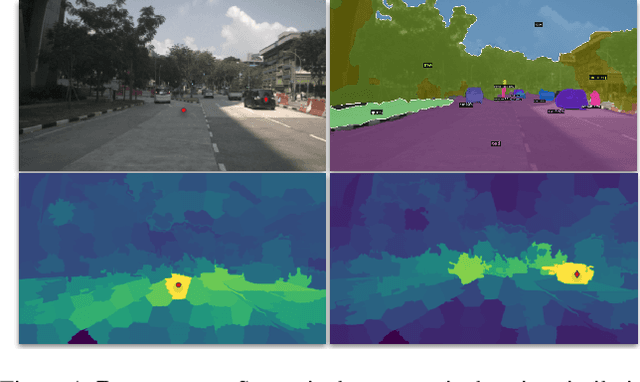
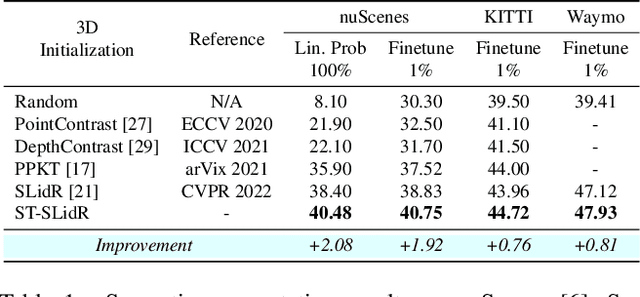
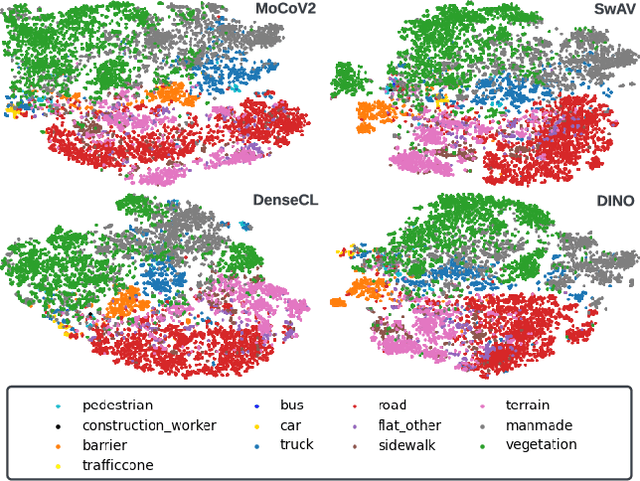
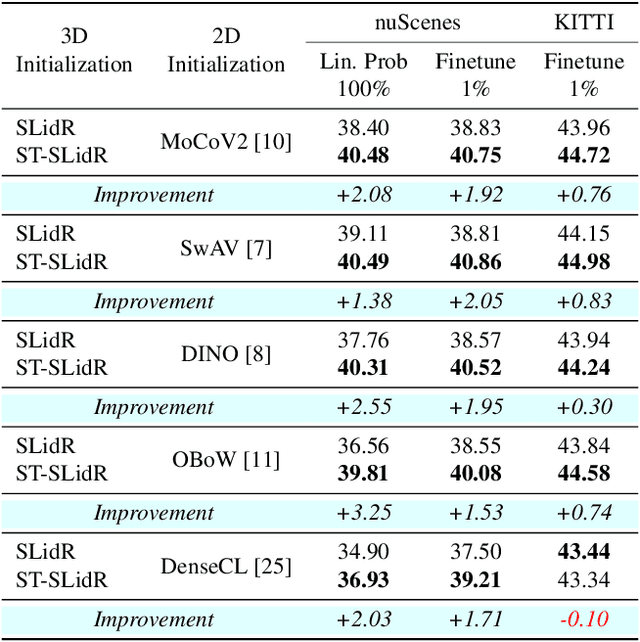
Abstract:An effective framework for learning 3D representations for perception tasks is distilling rich self-supervised image features via contrastive learning. However, image-to point representation learning for autonomous driving datasets faces two main challenges: 1) the abundance of self-similarity, which results in the contrastive losses pushing away semantically similar point and image regions and thus disturbing the local semantic structure of the learned representations, and 2) severe class imbalance as pretraining gets dominated by over-represented classes. We propose to alleviate the self-similarity problem through a novel semantically tolerant image-to-point contrastive loss that takes into consideration the semantic distance between positive and negative image regions to minimize contrasting semantically similar point and image regions. Additionally, we address class imbalance by designing a class-agnostic balanced loss that approximates the degree of class imbalance through an aggregate sample-to-samples semantic similarity measure. We demonstrate that our semantically-tolerant contrastive loss with class balancing improves state-of-the art 2D-to-3D representation learning in all evaluation settings on 3D semantic segmentation. Our method consistently outperforms state-of-the-art 2D-to-3D representation learning frameworks across a wide range of 2D self-supervised pretrained models.
Dense Voxel Fusion for 3D Object Detection
Mar 02, 2022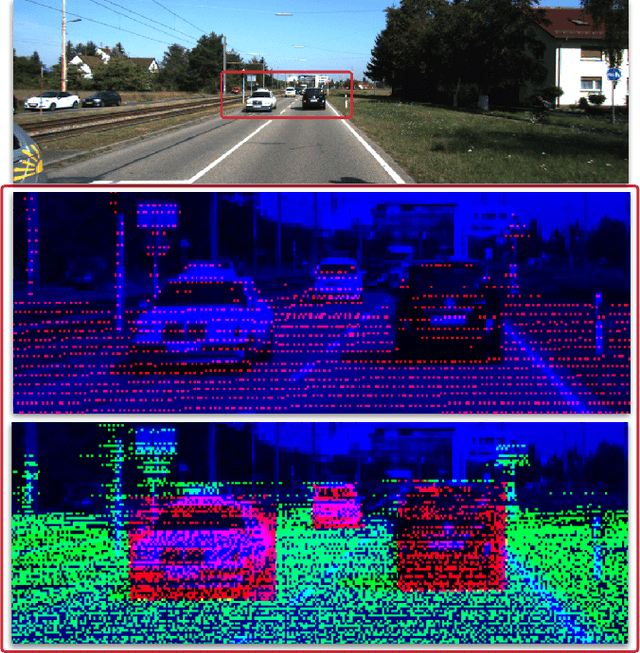
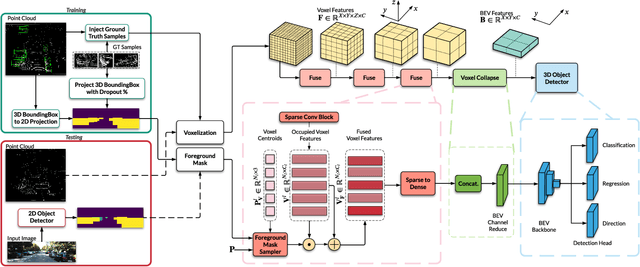
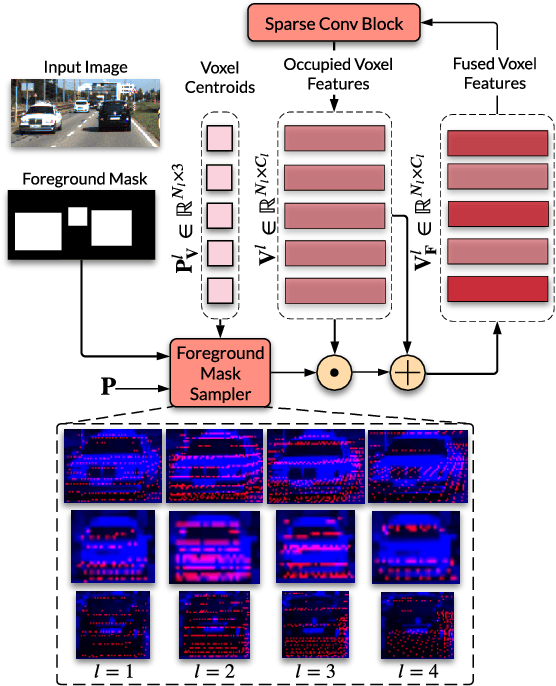
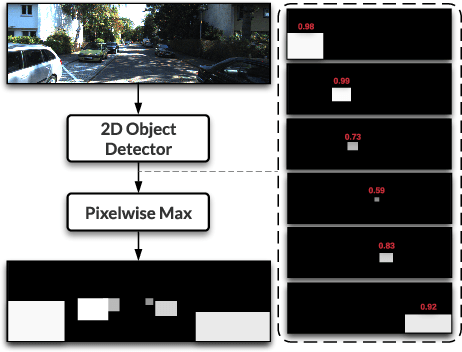
Abstract:Camera and LiDAR sensor modalities provide complementary appearance and geometric information useful for detecting 3D objects for autonomous vehicle applications. However, current fusion models underperform state-of-art LiDAR-only methods on 3D object detection benchmarks. Our proposed solution, Dense Voxel Fusion (DVF) is a sequential fusion method that generates multi-scale multi-modal dense voxel feature representations, improving expressiveness in low point density regions. To enhance multi-modal learning, we train directly with ground truth 2D bounding box labels, avoiding noisy, detector-specific, 2D predictions. Additionally, we use LiDAR ground truth sampling to simulate missed 2D detections and to accelerate training convergence. Both DVF and the multi-modal training approaches can be applied to any voxel-based LiDAR backbone without introducing additional learnable parameters. DVF outperforms existing sparse fusion detectors, ranking $1^{st}$ among all published fusion methods on KITTI's 3D car detection benchmark at the time of submission and significantly improves 3D vehicle detection performance of voxel-based methods on the Waymo Open Dataset. We also show that our proposed multi-modal training strategy results in better generalization compared to training using erroneous 2D predictions.
 Add to Chrome
Add to Chrome Add to Firefox
Add to Firefox Add to Edge
Add to Edge